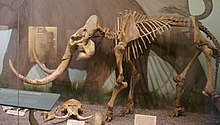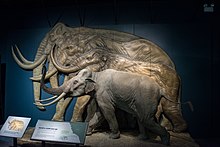
A mammoth is any species of the extinct elephantid genus Mammuthus. They lived from the late Miocene epoch into the Holocene about 4,000 years ago, and various species existed in Africa, Europe, Asia, and North America. Mammoths are distinguished from living elephants by their spirally twisted tusks and in at least some later species, the development of numerous adaptions to living in cold environments, including a thick layer of fur.

Proboscidea is a taxonomic order of afrotherian mammals containing one living family (Elephantidae) and several extinct families. First described by J. Illiger in 1811, it encompasses the elephants and their close relatives. Three species of elephant are currently recognised: the African bush elephant, the African forest elephant, and the Asian elephant.
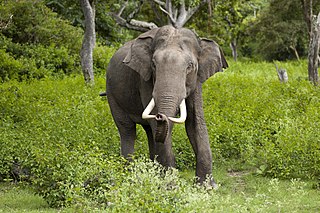
Elephantidae is a family of large, herbivorous proboscidean mammals collectively called elephants and mammoths. These are large terrestrial mammals with a snout modified into a trunk and teeth modified into tusks. Most genera and species in the family are extinct. Only two genera, Loxodonta and Elephas, are living.

Channel Islands National Park consists of five of the eight Channel Islands off the Pacific coast of the U.S. state of California. Although the islands are close to the shore of the densely populated state, they have been relatively undeveloped. The park covers 249,561 acres (100,994 ha), of which 79,019 acres (31,978 ha) are federal land.

Santa Rosae was, before the end of the last ice age, an ancient landmass off the coast of present-day southern California, near Santa Barbara County and Ventura County, of which the northern Channel Islands of California are remnants. At its largest, Santa Rosae was roughly 3-4 times bigger than the northern Channel Islands of today, nearly 125 km long from east to west. Between about 20,000 and 5,000 years ago, Santa Rosae lost about 70% of its land mass to post-glacial rising sea level, leaving behind a vast submerged landscape currently being explored by scientists. San Miguel, Santa Rosa, Santa Cruz, and Anacapa Island comprise the unsubmerged portions of Santa Rosae today. This island was about 5 miles offshore. It broke up between about 11,000 and 9,000 years ago, and the present northern Channel Islands took their shape after the continental ice sheets melted and sea levels rose by about 100 meters.
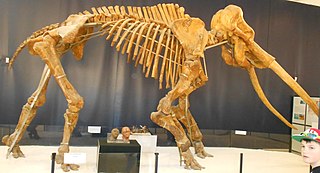
Palaeoloxodon is an extinct genus of elephant. The genus originated in Africa during the Early Pleistocene, and expanded into Eurasia at the beginning of the Middle Pleistocene. The genus contains some of the largest known species of elephants, over 4 metres (13 ft) tall at the shoulders, including the African Palaeoloxodon recki, the European straight-tusked elephant and the South Asian Palaeoloxodon namadicus. P. namadicus has been suggested to be the largest known land mammal by some authors based on extrapolation from fragmentary remains, though these estimates are highly speculative. In contrast, the genus also contains many species of dwarf elephants that evolved via insular dwarfism on islands in the Mediterranean, some only 1 metre (3.3 ft) in height, making them the smallest elephants known. The genus has a long and complex taxonomic history, and at various times, it has been considered to belong to Loxodonta or Elephas, but today is usually considered a valid and separate genus in its own right.

Stegodon is an extinct genus of proboscidean, related to elephants. It was originally assigned to the family Elephantidae along with modern elephants but is now placed in the extinct family Stegodontidae. Like elephants, Stegodon had teeth with plate-like lophs that are different from those of more primitive proboscideans like gomphotheres and mammutids. The oldest fossils of the genus are found in Late Miocene strata in Asia, likely originating from the more archaic Stegolophodon, subsequently migrating into Africa. While the genus became extinct in Africa during the Pliocene, Stegodon remained widespread in South, Southeast and East Asia until the end of the Pleistocene.

Dwarf elephants are prehistoric members of the order Proboscidea which, through the process of allopatric speciation on islands, evolved much smaller body sizes in comparison with their immediate ancestors. Dwarf elephants are an example of insular dwarfism, the phenomenon whereby large terrestrial vertebrates that colonize islands evolve dwarf forms, a phenomenon attributed to adaptation to resource-poor environments and lack of predation and competition.

The Columbian mammoth is an extinct species of mammoth that inhabited the Americas from southern Canada to Costa Rica during the Pleistocene epoch. The Columbian mammoth descended from Eurasian steppe mammoths that colonised North America during the Early Pleistocene around 1.5–1.3 million years ago, and later experienced hybridisation with the woolly mammoth lineage. The Columbian mammoth was among the last mammoth species, and the pygmy mammoths evolved from them on the Channel Islands of California. The closest extant relative of the Columbian and other mammoths is the Asian elephant.

Mammuthus meridionalis, sometimes called the southern mammoth, is an extinct species of mammoth native to Eurasia, including Europe, during the Early Pleistocene, living from around 2.5 million years ago to 800,000 years ago.

Mammuthus trogontherii, sometimes called the steppe mammoth, is an extinct species of mammoth that ranged over most of northern Eurasia during the Early and Middle Pleistocene, approximately 1.7 million-200,000 years ago. One of the largest mammoth species, it evolved in East Asia during the Early Pleistocene, around 1.8 million years ago, before migrating into North America around 1.5 million years ago, and into Europe during the Early/Middle Pleistocene transition, around 1 to 0.7 million years ago. It was the ancestor of the woolly mammoth and Columbian mammoth of the later Pleistocene.

Mammuthus lamarmorai is a species of dwarf mammoth which lived during the late Middle and Late Pleistocene on the island of Sardinia in the Mediterranean. It has been estimated to have had a shoulder height of around 1.4 metres (4.6 ft). Remains have been found across the western part of the island.

Palaeoloxodon cypriotes is an extinct species of dwarf elephant that inhabited the island of Cyprus during the Late Pleistocene. The species became extinct around 12,000 years ago, around the time humans first colonised Cyprus.

The woolly mammoth is an extinct species of mammoth that lived from the Middle Pleistocene until its extinction in the Holocene epoch. It was one of the last in a line of mammoth species, beginning with the African Mammuthus subplanifrons in the early Pliocene. The woolly mammoth began to diverge from the steppe mammoth about 800,000 years ago in Siberia. Its closest extant relative is the Asian elephant. The Columbian mammoth lived alongside the woolly mammoth in North America, and DNA studies show that the two hybridised with each other.
Primelephas is a genus of Elephantinae that existed during the Miocene and Pliocene epochs. The name of the genus suggests 'first elephant'. These primitive elephantids are thought to be the common ancestor of Mammuthus, the mammoths, and the closely allied genera Elephas and Loxodonta, the Asian and African elephants, diverging some 4-6 million years ago. It had four tusks, which is a trait not shared with its descendants, but common in earlier proboscideans. The type species, Primelephas gomphotheroides, was described by Vincent Maglio in 1970, with the specific epithet indicating the fossil specimens were gomphothere-like. Primelephas korotorensis is the only other species to be assigned to the genus. All fossils found of the Primelephas have been found in Africa, primarily in modern day Chad, Tanzania, Kenya, Ethiopia, and Uganda.
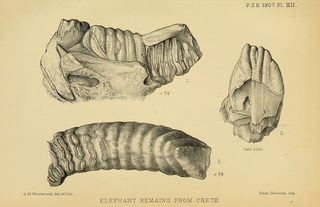
Mammuthus creticus, or the Cretan dwarf mammoth, is an extinct species of dwarf mammoth endemic to Crete during the Early Pleistocene to early Middle Pleistocene.
Mammuthus rumanus is a species of mammoth that lived during the Pliocene in Eurasia. It the oldest mammoth species known outside of Africa.
Bechan Cave is a single-room sandstone rock shelter located at an elevation of 1,280 metres (4,200 ft) along Bowns Canyon Creek, a tributary of the Glen Canyon segment of the Colorado River, in Kane County in southeastern Utah in the United States. The cave is roughly 31 metres (100 ft) wide, 9 metres (30 ft) high and 52 metres (170 ft) deep. It has a single entrance that faces southwest and is well-lit during the daytime.
Microtus (Tyrrhenicola) henseli is an extinct species of vole belonging to the genus Microtus that was endemic to Sardinia and Corsica during the Pleistocene and Holocene.
The Tuqan Man consists of human remains found on San Miguel Island off the coast of California in 2005. The skull and bones of a man buried between 9,800 and 10,200 years ago were exposed by beach erosion on this westernmost of the Channel Islands. The remains were encountered and preserved in 2005 by University of Oregon archaeologists. The remains were dated by way of radiocarbon dating and evaluation of artifacts which had been intentionally buried with him. Analysis of the bones indicated that he was in his forties when he died, and had spent time some distance east of what is now the Santa Barbara coastal region. It was not possible to extract the Tuqan Man's DNA, though increasingly better testing techniques and methods became available and were utilized over the 12 years that passed after his original discovery. The remains return to the island was delayed by resolution of tribal identification and ownership issues contingent on resolution of the precedent-setting Kennewick Man case from Washington State. Under procedures in accordance with the Native American Graves Protection and Repatriation Act (NAGPRA), in May, 2018, they were restored to the claiming Chumash tribe, for reburial on the island. The Chumash people had long occupied the island before the arrival of the first European explorers, and the find was given the place name of the island in the Chumash language.
